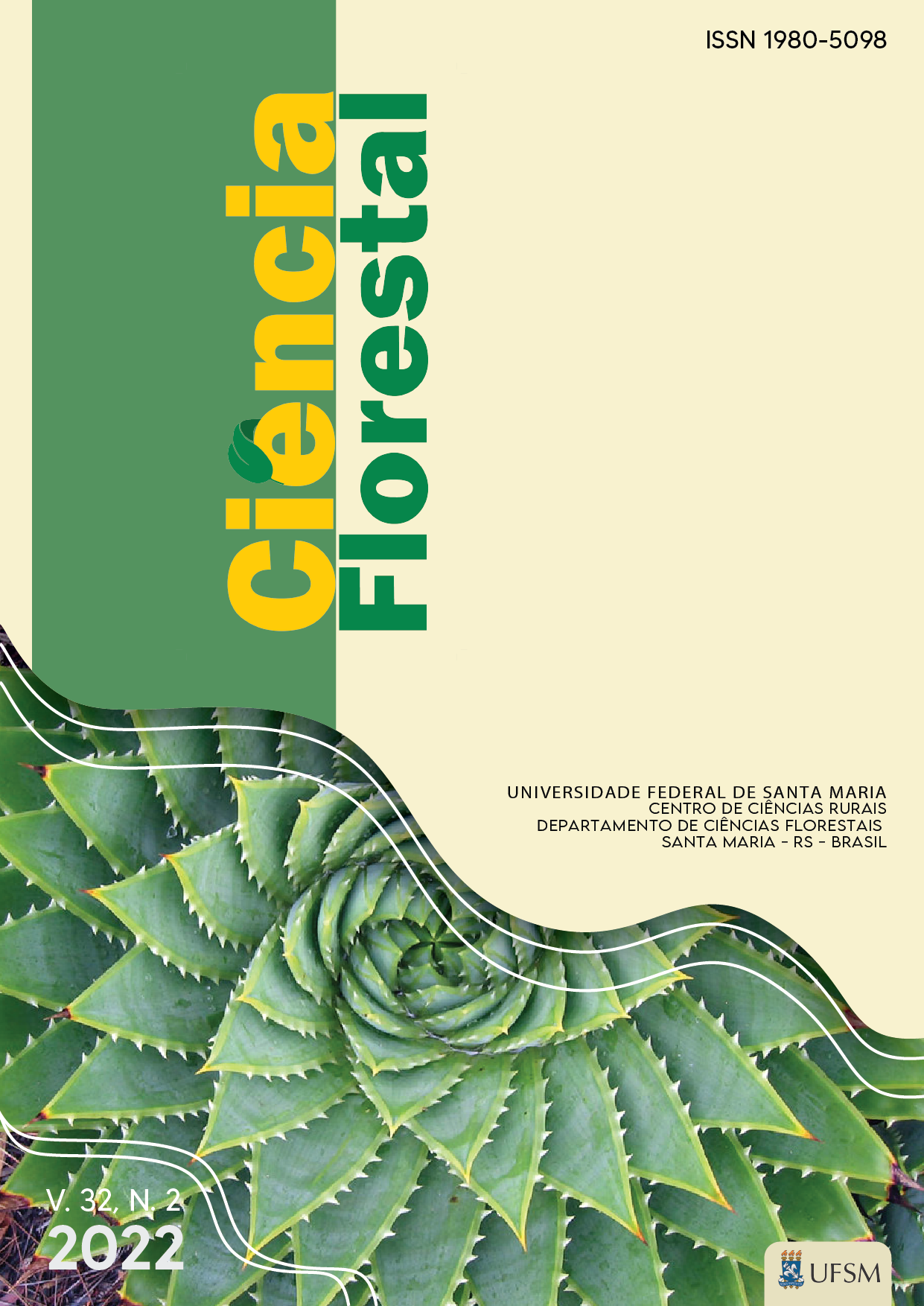Method of opening the fruits, biometry and anatomical description of embryonic development in pau-branco (<i>Cordia oncocalyx</i> Allemão) seeds
DOI:
https://doi.org/10.5902/1980509825216Keywords:
Caatinga, Wood extraction, Pau-branco, Propagation, AnatomyAbstract
The tree species Pau-branco, Cordia oncocalyx Allemão has great economic potential, especially for logging, but its extraction is uncontrolled and can cause depredation. This type of harvest does not guarantee sufficient raw material to supply the demanding sectors such as furniture industries. The propagation of the species in plant nurseries starting from fruits and seeds could offer a solution to this problem. However, the fruits obtained from native plants comprise different sizes and different degrees of ripeness, making germination and propagation processes a difficult task. Knowledge of the final zygotic embryogenesis (fruit phase) anatomy is very important to establishing a propagation protocol for this species, especially to achieve a successful seed rescue of those containing mature zygotic embryos. The objectives of the present work was to establish a method to open the fruits and to study the microstructure and anatomy of the embryo in seeds of pau-branco, never shown before, with the goal of determining in which phase of development seed rescue is most appropriate for subsequent planting and seedling propagation. Mature fruits of pau-branco at different developmental stages were collected and subjected to microscopic investigation or biometrics determination. Transverse and longitudinal sections were obtained and processed for optical and scanning electron microscopy for the anatomical description of fruits and seeds. It was observed that the fruit has an exocarp and mesocarp. The mesocarp is divided into a sub exocarp-like mesocarp and a sclerenchymatous mesocarp, the latter of which gives hardness and rigidity to the fruit. The embryo, generally approximately 1.5 cm, is visible inside the fruits. When the embryo reaches 2.0 cm, it is considered fully developed, and it is recommend that excision can take place at this stage. the use of a hydraulic press was the most viable method for the extraction of seeds from the fruits. Furthermore, it was also concluded that the embryo of pau-branco seeds contain protein reserves.
Downloads
References
ABIMCI (ASSOCIAÇÃO BRASILEIRA DA INDÚSTRIA DE MADEIRA PROCESSADA MECANICAMENTE). Estudo Setorial 2009, Ano Base 2008. Curitiba: ABIMCI, 2009. 43 p.
ANDRADE-LIMA, D. Plantas de Caatinga. Rio de Janeiro: Academia Brasileira de Ciências, 1989. 224p.
BRITO, L. B. M.; ARAÚJO, F. S. Banco de sementes de Cordia oncocalyx Allemão em uma área de Caatinga sobre planossolo. Revista Caatinga, Mossoró, v.22, n. 2, p. 206-212, abril/junho 2009.
CAMPANHA, M. M. et al. Perdas de solo, água e nutrientes pela erosão hídrica em diferentes sistemas de manejo agroflorestal no semiárido cearense. Embrapa Caprinos, Sobral, Circular Técnica, 37. Sobral: Embrapa Caprinos, 2008. 13p.
CARVALHO, P. E. R. Espécies arbóreas brasileiras. v. 2. Brasília: Embrapa Informação Tecnológica, 2006, 627p.
CARVALHO, P. E. R. Pau-Branco-do-Sertão (Auxemma oncocalyx). Embrapa Florestas, Colombo, Circular Técnica, 153. Colombo: Embrapa Florestas, 2008. 6 p.
CARVALHO, J. E. U.; NASCIMENTO,W. E. O. Caracterização dos pirênios e métodos para acelerar a germinação de sementes de muruci do clone açu. Revista Brasileira de Fruticultura, Jaboticabal, v. 30, n. 3, p.775-781, Setembro 2008.
GOTTSCHLING, M.; MILLER, J. S. Clarification of the taxonomic position of Auxemma, Patagonula, and Saccellium (Cordiaceae, Boraginales). Systematic Botany, Laramie, v. 31, n. 2, p. 361-367, 2006.
GUIMARÃES, I. P.; COELHO, M. F. B.; AZEVEDO, R. A. B. Pau branco (Cordia oncocalix Allemão) - Boraginaceae: Árvore endêmica da Caatinga. Revista Verde de Agroecologia e Desenvolvimento Sustentável, Pombal, v. 8, n. 5, p. 31 - 39, (Edição Especial) dezembro, 2013.
KIGEL, J.; GALILI, G. (Ed.). Seed development and germination. New York: Marcel Dekker, Inc., 1995. 853 p.
LORENZI, H. Árvores brasileiras: Manual de identificação e cultivo de plantas arbóreas nativas do Brasil. São Paulo: Nova Odessa, 1992. 362p.
MAIA, G.N. Caatinga: árvores e arbustos e suas utilidades. 1.ed. São Paulo: D&Z Computação Gráfica e Editora, 2004. 410p.
MMA (MINISTÉRIO DO MEIO AMBIENTE). Caatinga. Disponível em: http://www.mma.gov.br/biomas/caatinga. Acesso em: 12 set. 2013.
RODAL, M. J. N; SAMPAIO, E. V. S. B. A vegetação do bioma Caatinga. In: Sampaio, E. V. S. B. et al. (Eds.). Vegetação e Flora da Caatinga. Recife: Associação Plantas do Nordeste, Centro Nordestino de Informações sobre Plantas. 2002, p. 11 – 24.
SILVEIRA, A.P. Influência de predadores e patógenos na dominância regenerativa de duas espécies de Auxemma Miers. (Boraginaceae). 2002. Dissertação de Mestrado, Universidade Federal Rural de Pernambuco, Recife, Pernambuco, 2002.
SILVEIRA, A.P. et al. Predação de frutos e germinação de sementes em Auxemma oncocalyx (Allemão) Baill. eAuxemma glaziovianaTaub. In: NOGUEIRA, R.M.C. et al. (Eds.), Estresses ambientais: danos e benefícios em plantas. Recife: MXM, 2005. pp. 416-432.
SOUZA, L.A. 2008. Morphology and anatomy of the Cordia trichotoma (Vell.) Arrab. ex I. M. Johnst diaspore (Boraginaceae). Brazilian Archives of Biology and Technology, Curitiba, v. 51, n.4, p.761 - 768, 2008.
Published
How to Cite
Issue
Section
License
Copyright (c) 2022 Ciência Florestal

This work is licensed under a Creative Commons Attribution-NonCommercial 4.0 International License.
A revista CIÊNCIA FLORESTAL reserva-se o direito de realizar, nos originais, alterações de ordens normativas, ortográficas e gramaticais, com vistas a manter o padrão escolar da língua, mas respeitando o estilo dos autores. As provas finais podem ou não ser enviadas aos autores.






